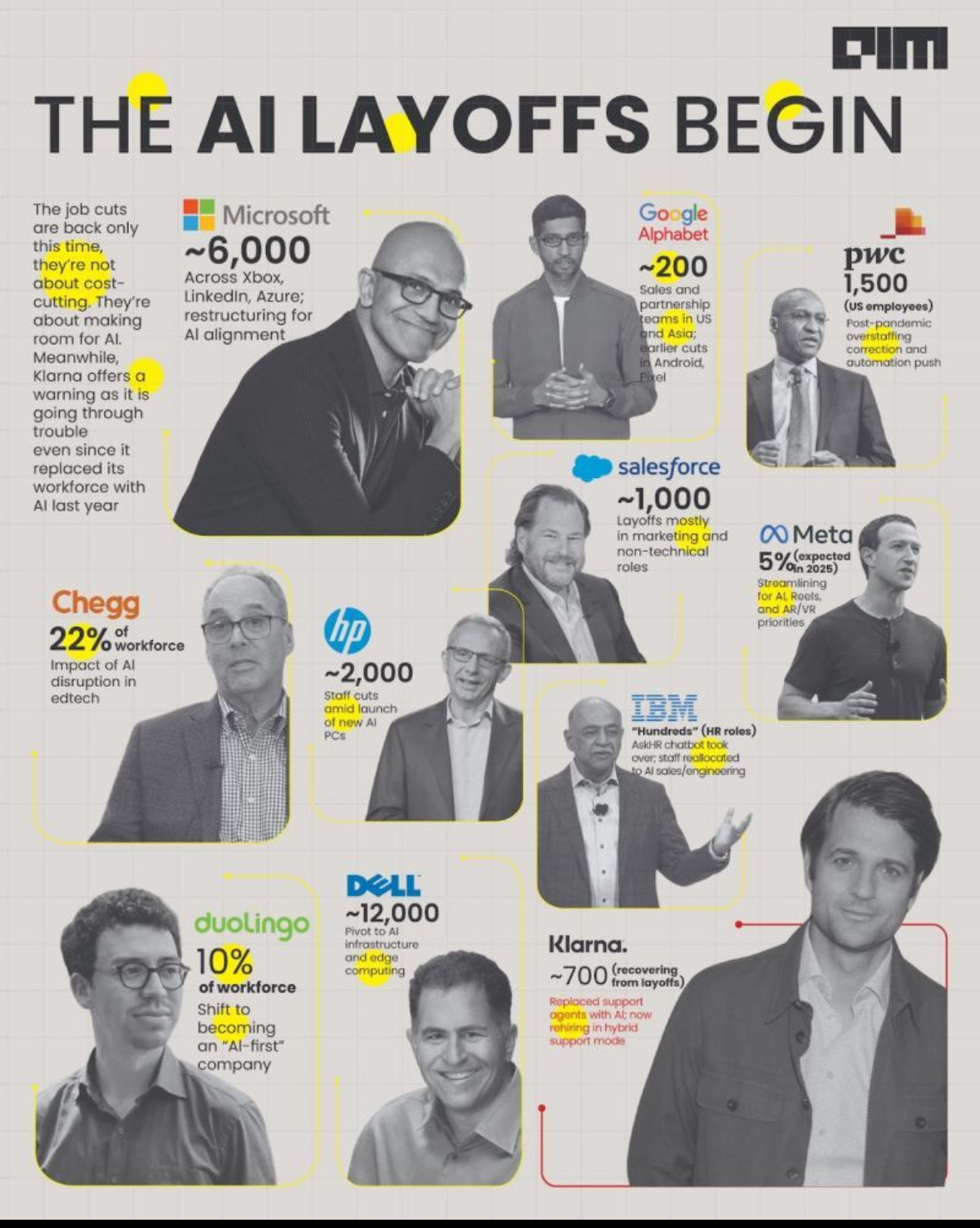AI's Second-Order Effects: The Business Opportunities Beyond Job Displacement
In the past few months, we've explored how AI is rewiring business operations—from EY deploying 150 specialized AI agents for tax work to Microsoft's "Frontier Firms" completely reimagining their processes around AI. But another reality is emerging: just six months into 2025, over 50,000 tech workers have lost their jobs.
From Microsoft and Google to IBM and PwC, companies aren't just cutting teams to save money—they're restructuring to make room for AI. Microsoft alone let go of 6,000+ employees, while Satya Nadella reports that 30% of their code is now AI-written.
These job cuts are scary, but before we panic, let's zoom out a bit. Throughout history, technological revolutions have consistently created more jobs than they've eliminated, though not always in obvious ways or immediate timeframes.
To understand where the real opportunities lie in this AI transformation, we need to distinguish between first and second-order effects.
First-Order vs. Second-Order Effects
First-order effects are the immediate, obvious impacts of AI:
AI writing emails and reports
Chatbots answering customer questions
AI helping programmers write code faster
Virtual assistants scheduling meetings
These are valuable but predictable. However, history suggests the real transformation comes from second-order effects - the ripple effects that happen as society adapts:
New jobs and industries emerging to support AI
Changes in how we train workers
Shifts in what skills become valuable
Entirely new business models
Think about smartphones: The first-order effect was communication and internet access. The second-order effects—which were harder to predict—included entirely new sectors like ride-sharing, mobile payments, and on-demand delivery.
The Evolution of Work: From Deskilling to Non-Skilling
To better understand where we are in this transformation, Stanford's Erik Brynjolfsson offers a useful framework for understanding how we've historically adapted to technological change in the workplace:
Deskilling: Where technology simplifies complex jobs (like assembly lines replacing craftsmen)
Upskilling: Where technology requires more advanced skills (like Excel transforming accounting)
Non-Skilling: Where AI might eliminate the need for human workers in some roles entirely
We're currently navigating between waves 2 and 3—and the businesses that thrive will be those that understand this transition. Let's look at a concrete example of a second-order opportunity that's emerging directly from this workforce transition.
Displacement Agencies: A Second-Order Opportunity
With all this change come both challenges and opportunities. A McKinsey study suggests that by 2030, at least 14% of employees globally will need to change careers due to technological disruption. This creates a significant opportunity for a new type of organization—what I call "displacement agencies."
These specialized organizations would help workers navigate career transitions by:
Identifying transferable skills workers already have
Providing targeted training for new skills
Offering career guidance through transitions
Connecting retrained workers with new opportunities
These agencies help both sides: workers who need new jobs and companies that need people with the right skills for AI. They solve the big problem that we are seeing when technology changes faster than people can keep up, potentially leaving many behind.
To learn more read my post "Displacement Agencies: Retooling and Reskilling to Keep Up With the Pace of Change", where I detailed how these organizations could help bridge the gap between technology's acceleration and our ability to adapt. I believe these agencies will become increasingly crucial for both individuals and the broader economy.
Your Next Move
While first-order effects like job displacement are immediate and visible, the second-order effects create entirely new industries, roles, and opportunities.
As we navigate between the upskilling and non-skilling phases of this transformation, the organizations that thrive won't be those merely replacing workers with AI, but those identifying the new human needs this shift creates. Whether it's displacement agencies helping workers transition, or entirely new business models we haven't yet imagined, the biggest opportunities often emerge from technology's second-order effects.
The key question isn't "Which jobs will AI replace?" but "What new human needs will emerge as AI transforms how we work?"—and that's where the next wave of innovation awaits.




Notable News (May 29,2025): Anthropic CEO Warns AI Could Eliminate Half of White-Collar Jobs Within 5 Years
Dario Amodei predicts AI could wipe out half of all entry-level white-collar jobs and spike unemployment to 10-20% in the next five years. He believes AI labs have an obligation to warn the public about the coming "white-collar bloodbath" across tech, finance, law, and consulting.
https://www.axios.com/2025/05/28/ai-jobs-white-collar-unemployment-anthropic?utm_source=tldrai